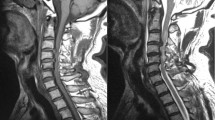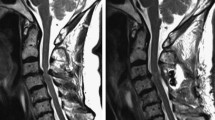Abstract
Purpose
The purpose of the study was to evaluate the clinical relationship between cervical spinal canal stenosis (CSCS) and incidence of traumatic cervical spinal cord injury (CSCI) without major fracture or dislocation, and to discuss the clinical management of traumatic CSCI.
Methods
Forty-seven patients with traumatic CSCI without major fracture or dislocation (30 out of 47 subjects; 63.83 %, had an injury at the C3–4 segment) and 607 healthy volunteers were measured the sagittal cerebrospinal fluid (CSF) column diameter at five pedicle and five intervertebral disc levels using T2-weighted midsagittal magnetic resonance imaging. We defined the sagittal CSF column diameter of less than 8 mm as CSCS based on the previous paper. We evaluated the relative and absolute risks for the incidence of traumatic CSCI related with CSCS.
Results
Using data from the Spinal Injury Network of Fukuoka, Japan, the relative risk for the incidence of traumatic CSCI at the C3–4 segment with CSCS was calculated as 124.5:1. Moreover, the absolute risk for the incidence of traumatic CSCI at the C3–4 segment with CSCS was calculated as 0.00017.
Conclusions
In our results, the relative risk for the incidence of traumatic CSCI with CSCS was 124.5 times higher than that for the incidence without CSCS. However, only 0.017 % of subjects with CSCS may be able to avoid developing traumatic CSCI if they undergo decompression surgery before trauma. Our results suggest that prophylactic surgical management for CSCS might not significantly affect the incidence of traumatic CSCI.
Similar content being viewed by others
References
Tewari MK, Gifti DS, Singh P, Khosla VK, Mathuriya SN, Gupta SN et al (2005) Diagnosis and prognostication of adult spinal cord injury without radiographic abnormality using magnetic resonance imaging: analysis of 40 patients. Surg Neurol 63:204–209
Gupta SK, Rajeev K, Khosla VK, Sharma BS, Paramjit SN, Pathak A et al (1999) Spinal cord injury without radiographic abnormality in adults. Spinal Cord 37:726–729
Kothari P, Freeman B, Grevitt M, Kerslake R (2000) Injury to the spinal cord without radiological abnormality (SCIWORA) in adults. J Bone Joint Surg Br 82:1034–1037
Wenger M, Adam PJ, Alarcon F, Markwalder TM (2003) Traumatic cervical instability associated with cord oedema and temporary quadriparesis. Spinal Cord 41:521–526
Koyanagi I, Iwasaki Y, Hida K, Akino M, Imamura H, Abe H et al (2000) Acute cervical cord injury without fracture or dislocation of the spinal column. J Neurosurgery 93:15–20
Tator CH (1995) Clinical manifestations of acute spinal cord injury. In: Benzel EC, Tator CH (eds) Contemporary management of spinal cord injury. Park Ridge, American Association of Neurological Surgeons, pp 15–26
Harrop JS, Sharan A, Ratliff J (2006) Central cord injury: pathophysiology, management, and outcomes. Spine J 6:198S–206S
Shimada K, Tokioka T (1995) Sequential MRI studies in patients with cervical cord injury but without bony injury. Paraplegia 33:573–578
Takahashi M, Harada Y, Inoue H, Shimada K (2002) Traumatic cervical cord injury at C3–4 without radiographic abnormalities: correlation of magnetic resonance findings with clinical feature and outcome. J Orthop Surg (Hong Kong) 10:129–135
Morishita Y, Naito M, Wang JC (2011) Cervical spinal canal stenosis: the differences between stenosis at the lower cervical and multiple segment levels. Int Orthop 35:1517–1522
Morishita Y, Naito M, Hymanson H, Miyazaki M, Wu G, Wang JC (2009) The relationship between the cervical spinal canal diameter and the pathological changes in the cervical spine. Eur Spine J 18:877–883
Okada Y, Ikata T, Yamada H, Sakamkto R, Katoh S (1993) Magnetic resonance imaging study on the results of surgery for cervical compression myelopathy. Spine 18:2024–2029
Herzog RJ, Weins JJ, Dillingham MF, Sontag MJ (1991) Normal cervical spine morphometry and cervical spine stenosis in asymptomatic professional football players. Spine 16:178–186
Anderson PA, Steinmetz MP, Eck JC (2006) Head and neck injuries in athletes. In: Spivak JM, Connolly PJ (eds) Orthopaedic knowledge update: Spine 3. Rosemont, AAOS, pp 259–269
Sakai H, Ueta T, Shiba K (2010) Current situation of medical care for spinal cord injury in Japan (in Japanese). J Spine Res 1:41–51
Edward WC, LaRocca H (1983) The developmental segmental sagittal diameter of the cervical spinal canal in patients with cervical spondylosis. Spine 8:20–27
Gore DR (2001) Roentgenographic findings in the cervical spine in asymptomatic persons: a ten-year follow-up. Spine 26:2463–2466
Yamazaki T, Yanaka K, Fujita K, Kamezaki T, Uemura K, Nose T (2005) Traumatic central cord syndrome: analysis of factors affecting the outcome. Surg Neurol 63:95–99
La Rosa G, Conti A, Cardali S, Cacciola F, Tomasello F (2004) Does early decompression improve neurological outcome of spinal cord injured patients? Appraisal of literature using a meta-analytical approach. Spinal Cord 42:503–512
Chen TY, Dickman CA, Eleraky M, Sonntag VKH (1998) The role of decompression for acute incomplete cervical spinal cord injury in cervical spondylosis. Spine 23:2398–2403
Bose B, Northrup BE, Osterholm JL, Cotler JM, DiTunno JF (1984) Reanalysis of central cervical cord injury management. Neurosurgery 15:367–372
Kawano O, Ueta T, Shiba K, Iwamoto Y (2010) Outcome of decompression surgery for cervical spinal cord injury without bone and disc injury in patients with spinal cord compression: a multicenter prospective study. Spinal Cord 48:548–553
Itoh Y, Mazaki T, Koshimune K, Morita T, Mizuno S (2011) Randomized controlled study of treatment for acute cervical cord injury with spinal canal stenosis but without radiographic evidence of trauma (SCIWORET): operative or conservative treatment. J Spine Res 2:965–967
Conflict of interest
None.
Author information
Authors and Affiliations
Corresponding author
Rights and permissions
About this article
Cite this article
Takao, T., Morishita, Y., Okada, S. et al. Clinical relationship between cervical spinal canal stenosis and traumatic cervical spinal cord injury without major fracture or dislocation. Eur Spine J 22, 2228–2231 (2013). https://doi.org/10.1007/s00586-013-2865-7
Received:
Revised:
Accepted:
Published:
Issue Date:
DOI: https://doi.org/10.1007/s00586-013-2865-7




